
Marietta, GA Wildlife Exclusion Specialists
Keeping Wild Animals Out of North Georgia Properties Since 2000
North Georgia is home to a stunning array of ecosystems, but the region’s growing suburban development has added unique challenges when it comes to wildlife management. When natural habitats are replaced by development, animals seek food and shelter in attics, crawlspaces, and yards.
Seasonal changes also drive wildlife indoors. During winter, animals like bats, rodents, and raccoons seek out warm, hidden spaces, while nesting season brings squirrels and birds looking for places to raise their young.
For over 20 years, we’ve provided homeowners and businesses across Marietta and North Georgia with science-based wildlife exclusion services. By securing access points and addressing attractants, we deliver effective, long-term solutions to help you keep nature outside where it belongs while preserving the delicate balance of our region’s ecosystems.
Call (470) 394-6305 or contact us online for a free quote on our exclusion services.
How Does Wildlife Exclusion Work?
Wildlife exclusion is about more than just driving animals away — it’s about creating barriers and conditions that prevent future infestations. Our exclusion process is backed by years of hands-on experience and the use of advanced tools and techniques.
Step 1: Inspection and Discovery
The first step is a comprehensive inspection of your property to identify how wildlife is entering. Many animals, like rodents, use tiny cracks or gaps in your foundation. Squirrels or raccoons might exploit open soffits, while bats prefer gaps along your roofline.
During this phase, we also utilize specialized tools such as moisture meters, UV lights, and telescoping cameras. These allow us to identify even the smallest or hardest-to-see entry points, from crawl spaces to attic corners. Finding every possible way an animal could be entering is critical for successful exclusion.
Step 2: Sealing Entry Points
Once entry points are identified, our technicians carefully seal them off using durable, weather-resistant materials. Depending on the area, this may include custom barriers. Openings used by protected species, like bats, will be handled with additional care to comply with state and federal guidelines.

Common Species Targeted by Exclusion
When you live in a beautiful area like North Georgia, you’re inevitably sharing it with wildlife. Below are some of the most common species that can be dealt with using comprehensive exclusion strategies.
Raccoons
Raccoons are smart, curious, and opportunistic. They’re skilled at getting into attics, basements, and chimneys in search of food. While they may look cute, raccoons can be a major nuisance. Once inside, they can cause structural damage, leave behind waste, and even pose health risks through the spread of diseases like rabies and roundworm. Their ability to climb and manipulate objects makes them one of the trickiest species to keep out.
Squirrels
With their impressive climbing abilities, squirrels often find rooflines and attic spaces irresistible. These energetic rodents can squeeze through openings as small as a couple of inches. Once inside, they can chew through wiring, wood, and insulation, creating fire hazards and expensive repair bills. Exclusion techniques focus on sealing entry points and managing tree canopy growth near your property to keep these busy critters out.
Bats
Bats are vital for our ecosystem, helping to keep insect populations under control. However, that doesn’t mean you want them roosting in your attic. Bat droppings, or guano, can cause respiratory issues in humans. In Georgia, strict regulations prohibit handling bats indiscriminately, and exclusion activities are prohibited during maternity season. We are knowledgeable about local regulations and are equipped to work around restrictions.
Rodents
Rodents are a year-round problem in many homes, especially in urban and suburban areas. These small creatures can slip through minute cracks and holes. Inside, they breed rapidly and chew through everything from stored food items to electrical cables. Rodent infestations carry health risks like Hantavirus and salmonella, making exclusion a key preventative step to protect your home.
Birds
While birds might seem harmless, certain species like pigeons and starlings can become pests. They create nests in vents, eaves, or gutters, obstructing airflow or causing water damage. Cleaning up bird droppings is also a health hazard due to the risk of histoplasmosis. Exclusion measures such as mesh installations and deterrents are highly effective in keeping them away.
Snakes
Though snakes play an important role in controlling rodent populations, they’re not welcome visitors inside homes or close to where children and pets play. Exclusion services for snakes involve sealing gaps, especially around foundations and crawl spaces, to minimize entry points. Managing rodent populations also helps, as they are a primary food source for snakes.